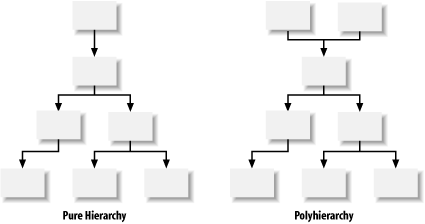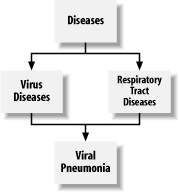Polyhierarchy
In a strict hierarchy, each term appears in one and only one place. This was the original plan for the biological taxonomy. Each species was supposed to fit neatly into one branch of the tree of life.
kingdom:
phylum:
sub-phylum:
class:
order:
family:
speciesHowever, things didn’t go according to plan. In fact, biologists have been arguing for decades over the correct placement of various species. Some organisms have the audacity to exhibit characteristics of multiple categories.
If you’re a purist, you can attempt to defend the ideal of strict hierarchy within your web site. Or, if you’re pragmatic, you can allow for some level of polyhierarchy, permitting some terms to be cross-listed in multiple categories. This is shown in Figure 9-24.

Figure 9-24. Hierarchy and polyhierarchy
When you’re dealing with large information systems, polyhierarchy is unavoidable. As the number of documents grows, you need a greater level of pre-coordination (using compound terms) to increase precision, which forces polyhierarchy. For example, Medline cross-lists viral pneumonia under both virus diseases and respiratory tract diseases (Figure 9-25).

Figure 9-25. Polyhierarchy in Medline
Yahoo! is another large site that makes prolific use of polyhierarchy (Figure 9-26). The @ signs are used ...
Get Information Architecture for the World Wide Web, Second Edition now with the O’Reilly learning platform.
O’Reilly members experience books, live events, courses curated by job role, and more from O’Reilly and nearly 200 top publishers.

